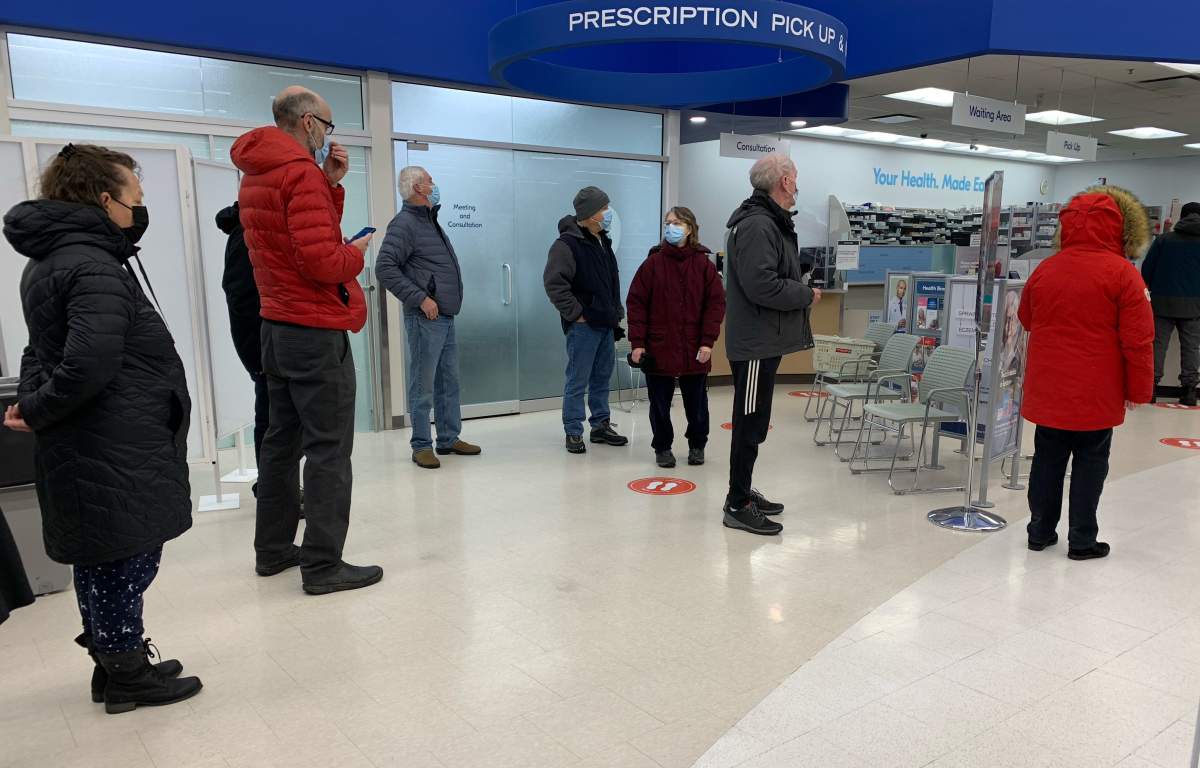Albertans were greeted with long lines Friday morning as COVID-19 rapid test kits became available to the general public.

As of 9:15 a.m., Alberta Health Services tweeted test sites in Lethbridge, Medicine Hat, Pincher Creek and Coaldale had run out of kits. AHS assured residents more would be available next week.
The AHS site in Gibbons also ran out before 12:30 p.m.
A full list of sites with kits is available on the government’s website.

Premier Jason Kenney announced a slight change to gathering restrictions for the holidays on Wednesday and also announced any Albertan with an Alberta health care card can receive a rapid testing kit. The kit includes five tests and is designed to be used every 72 hours.

Albertans can get a new free kit every two weeks.
“Definitely a highlight of the announcement,” Dr. Joe Vipond, a Calgary ER doctor, said on Wednesday.
“Omicron is a beast so we really need to be on top of that.”
With this new tool to slow the spread of COVID-19, many are now asking how and when should these tests be used?
When to conduct a rapid test
These tests need to be used in a wise fashion as part of a comprehensive series of safety measures to slow the spread of COVID-19, Vipond said.

Get weekly health news
“If you’re getting five every two weeks, and you can actually do that, one option is to just test yourself regularly and make sure that when you get COVID you catch it early in that asymptomatic phase,” he said.

You can also use it if you’re feeling early symptoms like a sniffle or a tickle in the back of the throat.
“Over the last two years I seem to always be, ‘Is that COVID? Is that a scratchy back of my throat?’ What’s going on there?’ So that’s another use,” he said.
The final regular use Vipond would recommend is for any close contact.
“So, say a kid… is exposed to somebody with COVID in their classroom, everybody in that classroom should be serially tested for the next week or so, so that we catch those early asymptomatic people.”

If using as a precursor to private indoor gathering, Vipond warns these tests need to be used immediately before.
“When I say immediately, it can’t be 24 hours or 36 hours or 72 hours before. It really should be 15 minutes before entering that space,” he said. “We’ve seen instances where people have been tested the day before and still become that patient zero, spreading it in a super spreader event.”
Vipond said the announcement of the rapid tests and the province continuing to open more availability to booster shots are “great moves” from the government, but urged Albertans to be careful not to over rely on these tests.
Even if a negative result is received, Albertans must continue to follow all public health guidelines in place, the government said.

How to use a COVID-19 rapid test
Each kit will contain five tests because it takes time for enough protein to be detected by a rapid test after being exposed to COVID-19.
Albertans are to perform rapid tests twice per week for two weeks as long as you are asymptomatic. The tests can be used on people aged 14 and older and adults can perform them on children aged two to 13.
According to a video on the province’s website, follow these steps to perform a COVID-19 rapid test:
- All materials in the test need to be at room temperature before starting.
- Open the pouch and lay the test cassette (the device that will read whether you have COVID-19) on a clean, flat surface.
- Add the extraction buffer liquid to a testing tube.
- For a test kit with a bottle, add 10 drops. For test kits with a single-use ampoule, add the full ampoule.
- Blow your nose and then remove the swab from the packaging, being careful not to touch the tip to anything.
- Tilt your head back and insert the swab at least half an inch inside the nostril and swab for at least five seconds. Then, compress your nostril against the swab and rotate the tip of the swab for at least five seconds.
- If performing the test on a child, only insert the swab 1.5 centimetres and no more than two centimetres.
- Repeat the procedure in the other nostril with the same swab.
- Tilt the tube with the extraction fluid and insert the swab, submerging the entire swab head in the solution.
- Mix well and squeeze the swab head 10-15 times by squishing the tube against the swab.
- Set the tube back in the tube stand and, using a timer, let the solution stand for two minutes.
- Squeeze as much liquid as possible out of the swab by pinching the tube and safely dispose of the swab.
- Place the provided nozzle on the tube and drop three drops of solution into the sample well on the test cassette (the spot marked S).
- Set a timer for 15 minutes.
- A positive result will show two lines: a line in the control region (the spot marked C) and any visible line in the test region (the spot marked T). Even a faint line in the test region is to be considered a positive result.
- A negative result shows a line only in the control region and no apparent line in the test region.
- If there is no line in the control region, the result is invalid.
- In the case of an invalid test, the test must be discarded and conducted again.
- If the problem persists, discontinue use and contact the agency where you got your kit.
A way to keep time is required for the test, but is not provided in the kit.










Comments